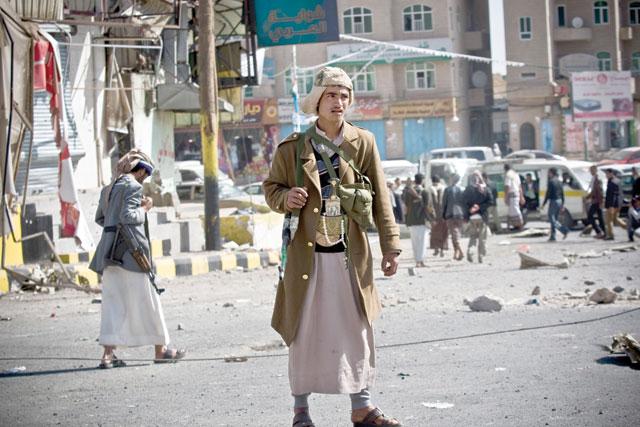You are here
Deadly battles in capital as Yemen crisis deepens
By AFP - Jan 19,2015 - Last updated at Jan 19,2015

SANAA — Shiite militia fought deadly battles with the army in Yemen's capital on Monday before a ceasefire took hold, in the biggest challenge yet to President Abed Rabbo Mansour Hadi's rule.
At least nine people were killed as the militia, known as Houthis, seized an army base near the presidential palace in Sanaa and took control of state media as well as fired on a convoy carrying the prime minister.
The ceasefire came into effect after several hours, with a security official saying it had been agreed in a meeting of the defence and interior ministers with a Houthi representative.
This was confirmed by the interior ministry, and residents in areas around the presidential palace said the fighting had subsided.
A joint committee of the government and Houthis was later formed to ensure the ceasefire is adhered to.
At least nine people were killed in Monday's violence, including fighters from both sides, and 67 people were wounded, among them civilians, said Deputy Health Minister Nasser Baoum.
The clashes raised international concerns, with the Arab League, Britain and the United States calling for their immediate end.
The Houthis seized control of Sanaa in September and strategically important Yemen — which borders Saudi Arabia and is on key Gulf shipping routes — has since been wracked by unrest.
The violence has raised fears that Hadi's government, which is a key ally in Washington's fight against Al Qaeda, will collapse and that Yemen will become a failed state similar to Somalia.
The Houthis appeared to be tightening their hold on the capital on Monday, saying they had seized an army base on a hill overlooking the presidential palace.
Information Minister Nadia Sakkaf said they had also taken total control of state television and the official news agency.
State TV, news agency seized
"Yemeni satellite channel is not under state control, nor is state news agency Saba. The Houthis have completely controlled them and are refusing to publish any government statements," she tweeted.
Sakkaf said Houthis had also fired on Prime Minister Khalid Bahah's convoy as he left the presidential residence but that he was unharmed.
Witnesses said the fighting erupted early Monday after the militia deployed reinforcements near the presidential palace.
The military presidential guard sent troops onto the streets surrounding the palace and outside Hadi’s residence.
A security official said the army intervened when the Houthis began to set up a new checkpoint near the presidential palace.
But a prominent Houthi chief, Ali Al Imad, accused the presidential guard of provoking the clashes.
“Hadi’s guard is trying to blow up the situation on the security front to create confusion on the political front,” he said on Facebook.
Tensions have been running high in Sanaa since the Houthis abducted Hadi’s chief of staff, Ahmed Awad Bin Mubarak, in an apparent bid to extract changes to a draft constitution that he is overseeing.
Mubarak is in charge of a “national dialogue” set up after veteran strongman Ali Abdullah Saleh was forced from power in February 2012 following a year of bloody Arab Spring-inspired protests.
The Houthis said they had seized him to prevent the violation of a UN-brokered agreement that provided for the formation of a new government and the appointment of Houthis as presidential advisers.
It stipulated that in return the Houthis would withdraw from key state institutions.
‘Spiralling out of control’
Mubarak’s kidnapping came just before a meeting of the national dialogue secretariat to present a draft constitution dividing Yemen into a six-region federation, which the Houthis oppose.
The rebels, who hail from Yemen’s remote north and fought a decade-long war against the government, rejected the decentralisation plan last year, claiming it divides the country into rich and poor regions.
“The Houthis’ decision to kidnap Mubarak was a serious escalation that now appears to be spiralling out of control,” said April Longley Alley, an analyst with the International Crisis Group.
Since their takeover of the capital, the Houthis, also known as Ansarullah, have pressed their advance into areas south of Sanaa, where they have met deadly resistance from Sunnis including Al Qaeda loyalists.
Yemen’s branch of the jihadist network, Al Qaeda in the Arabian Peninsula, is considered its most dangerous and claimed responsibility for this month’s attack in Paris on French satirical weekly Charlie Hebdo that left 12 dead.
Hadi’s government has been a key ally of the United States, allowing Washington to carry out regular drone attacks on Al Qaeda militants in its territory.
Related Articles
Shiite militia fighters attacked Yemeni President Abed Rabo Mansour Hadi's residence and seized the presidential palace Tuesday in what officials said was a bid to overthrow his embattled government.
Yemeni President Abed-Rabbo Mansour Hadi resigned on Thursday, a government spokesman said, throwing the country deeper into chaos days after Houthi rebels battled their way into his presidential palace.
Forces loyal to Yemen's president said they had seized strategic buildings in the southern city of Aden on Monday after a five-hour battle, escalating a civil conflict threatening to split the country in two.














